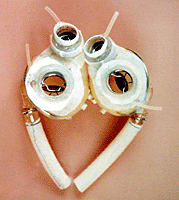This device is described here for historical purposes. It is no longer in use.
In July 1981, Dr. Denton A. Cooley again implanted a total artificial heart, the second such procedure in the world. Developed by Dr. Tetsuzo Akutsu at the Texas Heart Institute, the Akutsu III total artificial heart was implanted in a 36-year-old man. The Akutsu III kept the man alive for 55 hours, until a donor heart was found for transplantation.
 The Pump
The Pump
The Akutsu III total artificial heart contained two air-powered, double-chambered pumps. The pumping chambers were made of a smooth material called Avcothane™, which could be molded in one piece. The inflow and outflow ports contained Bjork-Shiley disc valves. The prosthetic ventricles were attached to the remnants of the natural heart's atria and to the great vessels by flexible inflow and outflow conduits with detachable quick-connectors. The pumps were connected with Dacron™ velour-covered tubing to an external control console.
The Console
The control console was composed of three basic systems: a pneumatic (air-driven) drive system, an electrical monitoring/control system, and an electrical power system.
- The pneumatic drive system provided both pressure and vacuum to each ventricle. Under normal use, the console was connected to wall pressure and vacuum sources. During patient transport, or in the event of in-house power failure, the system automatically switched to on-board compressed air tanks.
- Monitoring of heart rate and systolic duration were the primary functions of the electrical monitoring/control system. The monitoring/control system provided a digital readout of drive-line pressure and vacuum supplied, as well as the status of standard and emergency power supplies.
- The electrical power system had two independent sources of power: standard AC/DC power and a back-up battery in case of power failure.
For more information, you can read an article entitled, "Total Artificial Heart in Two-Staged Cardiac Transplantation," which appears in Volume 8 (1981) of the Texas Heart Institute Journal (pp. 305-319).
Updated April 2006



